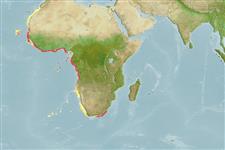>
Ateleopodiformes (Jellynose fishes) >
Ateleopodidae (Jellynose fishes)
Eponymy: Professor Dr Isao Ijima (1861–1921) was Professor of Zoology at Science College, Imperial University of Tokyo (1885–1921) from where he had graduated (1881). [...] Dr Etienne Loppé (1883–1954) was a physician who qualified in Paris. [...] (Ref. 128868), visit book page.
Environment: milieu / climate zone / depth range / distribution range
Écologie
marin bathydémersal; profondeur 200 - 998 m (Ref. 6550). Deep-water; 31°N - 35°S
Eastern Atlantic: Morocco to South Africa.
Taille / Poids / Âge
Maturity: Lm ? range ? - ? cm
Max length : 200 cm TL mâle / non sexé; (Ref. 36731)
Description synthétique
Clés d'identification | Morphologie | Morphométrie
Épines dorsales (Total) : 0; Rayons mous dorsaux (Total) : 9 - 10; Épines anales: 0; Rayons mous anaux: 78 - 85. Dark brown to black in color, lighter below; pelvic ray and fold of skin at angle of mouth pale (Ref. 5528).
Inhabits upper slopes (Ref. 27121). Feeds on ophiuroids and fishes (Ref. 6717).
Life cycle and mating behavior
Maturité | Reproduction | Frai | Œufs | Fécondité | Larves
Costa, M.J. and J.-C. Quéro, 1990. Ateleopodidae. p. 644-645. In J.C. Quero, J.C. Hureau, C. Karrer, A. Post and L. Saldanha (eds.) Check-list of the fishes of the eastern tropical Atlantic (CLOFETA). JNICT, Lisbon; SEI, Paris; and UNESCO, Paris. Vol. 2. (Ref. 6550)
Statut dans la liste rouge de l'IUCN (Ref. 130435: Version 2024-1)
Menace pour l'homme
Harmless
Utilisations par l'homme
Outils
Articles particuliers
Télécharger en XML
Sources Internet
Estimates based on models
Preferred temperature (Ref.
123201): 8.7 - 13.7, mean 10.7 °C (based on 21 cells).
Phylogenetic diversity index (Ref.
82804): PD
50 = 0.5315 [Uniqueness, from 0.5 = low to 2.0 = high].
Bayesian length-weight: a=0.00389 (0.00180 - 0.00842), b=3.12 (2.94 - 3.30), in cm total length, based on all LWR estimates for this body shape (Ref.
93245).
Niveau trophique (Ref.
69278): 4.3 ±0.71 se; based on food items.
Fishing Vulnerability (Ref.
59153): Very high vulnerability (90 of 100).
